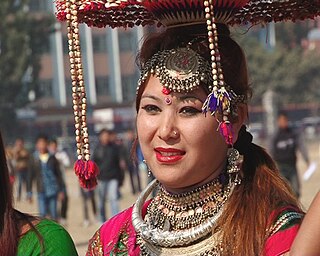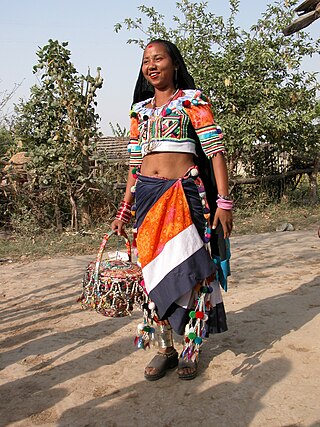Related Research Articles

The Indo-Aryan languages are a branch of the Indo-Iranian languages in the Indo-European language family. As of the early 21st century, they have more than 800 million speakers, primarily concentrated in India, Pakistan, Sri Lanka, Bangladesh, Nepal and Maldives. Moreover, apart from the Indian subcontinent, large immigrant and expatriate Indo-Aryan–speaking communities live in Northwestern Europe, Western Asia, North America, the Caribbean, Southeast Africa, Polynesia and Australia, along with several million speakers of Romani languages primarily concentrated in Southeastern Europe. There are over 200 known Indo-Aryan languages.
Bihari languages are a group of the Indo-Aryan languages. The Bihari languages are mainly spoken in the Indian states of Bihar, Jharkhand, Uttar Pradesh, and West Bengal, and also in Nepal. The most widely spoken languages of the Bihari group are Bhojpuri, Magahi and Maithili.

Marwari is a language within the Rajasthani language family of the Indo-Aryan languages. Marwari and its closely related varieties like Dhundhari, Shekhawati and Mewari form a part of the broader Marwari language family. It is spoken in the Indian state of Rajasthan, as well as the neighbouring states of Gujarat and Haryana, some adjacent areas in eastern parts of Pakistan, and some migrant communities in Nepal. There are two dozen varieties of Marwari. Marwari is also referred to as simply Rajasthani.

The Tharu people are an ethnic group indigenous to the Terai in southern Nepal and northern India. They speak Tharu languages. They are recognized as an official nationality by the Government of Nepal. In the Indian Terai, they live foremost in Uttarakhand, Uttar Pradesh and Bihar. The Government of India recognizes the Tharu people as a scheduled Indian tribe.
Magar Dhut is a Sino-Tibetan language spoken mainly in Nepal, southern Bhutan, and in Darjeeling and Sikkim, India, by the Magar people. It is divided into two groups and further dialect divisions give distinct tribal identity. In Nepal 810,000 people speak the language.

Tamang is a term used to collectively refer to a dialect cluster spoken mainly in Nepal, Sikkim, West Bengal (Darjeeling) and North-Eastern India. It comprises Eastern Tamang, Northwestern Tamang, Southwestern Tamang, Eastern Gorkha Tamang, and Western Tamang. Lexical similarity between Eastern Tamang and other Tamang languages varies between 81% and 63%. For comparison, lexical similarity between Spanish and Portuguese, is estimated at 89%.

Doti, also known as Dotigarh (डोटीगढ़) or the Far-Western Development Region was a development region of Nepal situated between River Kali bordering Kumaon division of Uttarakhand, India in the west and the Karnali river on the east. Doti was one of eight different princely states of the Katyuri Kingdom.

Languages of Nepal, referred to as Nepalese languages in the country's constitution, are the languages having at least an ancient history or origin inside the sovereign territory of Nepal spoken by Nepalis. The 2011 national census listed 123 languages spoken as a mother tongue in Nepal. Most belong to the Indo-Aryan and Sino-Tibetan language families.
Bajjika is an Indo-Aryan language variety spoken in parts of Bihar, India and in Nepal. It is closely related to Maithili.

The Tharu or Tharuhat languages are any of the Indo-Aryan languages spoken by the Tharu people of the Terai region in Nepal, and neighboring regions of Uttarakhand, Uttar Pradesh and Bihar in India.
The Baale language, Baleesi or Baalesi is a Surmic language spoken by the Baale or Zilmamo people of Ethiopia, and by the Kachepo of South Sudan. It is a member of the southwest branch of the Surmic cluster; the self-name of the language and the community is Suri, which is the same as that of the Suri language, evoking an ethnonym that embraces the Tirma, Chai, and Baale communities, although linguistically the languages of these communities are different. There are currently 9,000 native speakers of Baleesi, 5,000 in South Sudan and 4,100 in Ethiopia; almost all of these are monolingual.
Most of the languages of Bihar, the third most populous state of India, belong to the Bihari subgroup of the Indo-Aryan family. Chief among them are Bhojpuri, spoken in the west of the state, Maithili in the north, Magahi in center around capital Patna and in the south of the state. Maithili has official recognition under the Eighth Schedule to the Constitution of India. The official language of Bihar is Modern Standard Hindi, with Standard Urdu serving as a second official language in 15 districts.
Thangmi, also called Thāmī, Thangmi Kham, Thangmi Wakhe, and Thani, is a Sino-Tibetan language spoken in central-eastern Nepal and northeastern India by the Thami people. The Thami refer to their language as Thangmi Kham or Thangmi Wakhe while the rest of Nepal refers to it as Thāmī. The majority of these speakers, however, live in Nepal in their traditional homeland of Dolakhā District. In India, the Thami population is concentrated mostly in Darjeeling. The Thangmi language is written using the Devanagari script. Thangmi has been extensively documented by Mark Turin.
Rawang, also known as Krangku, Kiutze (Qiuze), and Ch’opa, is a Sino-Tibetan language of India and Burma. Rawang has a high degree of internal diversity, and some varieties are not mutually intelligible. Most, however, understand Mutwang (Matwang), the standard dialect, and basis of written Rawang.

Jaḍgālī is an Indo-Aryan language spoken by the Jadgal, an ethno-linguistic group of Pakistan and Iran also spoken by few hundreds in Oman. It is one of only two Indo-Aryan languages found on the Iranian plateau. It is a dialect of Sindhi language most closely related to Lasi.

Kagate or Syuba is a language from the subgroup of Tibetic languages spoken by the Kagate people primarily in the Ramechhap district of Nepal.
Kochila Tharu, also called Morangiya, Septari or Saptariya Tharu, Madhya-Purbiya Tharu, and Mid-Eastern Tharu, is a diverse group of language varieties in the Tharu group of the Indo-Aryan languages. The several names of the varieties refer to the regions where they dominate. It is one of the largest subgroupings of Tharu. It is spoken mainly in Nepal with approximately 250,000 speakers as of 2003. In addition to language, cultural markers around attire and customs connect individuals into the ethnic identity Kochila.

Rana Tharu is an ethnic group generally classified as part of the Tharu people of Nepal and India. They are living in Kailali and Kanchanpur Districts of the far western Nepali Terai and also in India, in Udham Singh Nagar district, Uttarakhand and Kheri district of Uttar Pradesh. As of 2001, Rana Tharu people were the largest of five scheduled tribes in Uttarakhand, with a population of 256,129 accounting for 33.4% of all scheduled tribes.
Kathariya Tharu also known as Kathoriya Tharu is one of the Indo Aryan languages spoken by the Tharu people of Nepal and India. It is a language spoken in the Sudurpashchim Province of Nepal, particularly in the Kailali District, including areas like Bardagoriya, Bhajani, Ghodaghodi, Joshipur. Additionally, it is spoken in the Uttar Pradesh state of India, specifically in Bahraich and Lakhimpur Kheri districts near the Nepal border.
Rana Tharu is a Indo Aryan language spoken by the Rana Tharu people who are part of the Tharu ethnic group in the Sudurpashchim Province of Nepal, specifically in the Kanchanpur district's southern municipalities and Dhangadhi in the Kailali district. Rana Tharu is also spoken in specific areas of Uttar Pradesh, India including the Lakhimpur Kheri district, particularly in Palia Kalan and Chandan Chauki block, situated on the India–Nepal border. Additionally, it is spoken in the Udham Singh Nagar district of Uttarakhand state. It exhibits high intelligibility among its dialects, with reported percentages ranging from 96% to 99%. The language has linguistic distinctions with dialects in India and shows lexical similarities with Awadhi and Buksa as well.
References
- ↑ Sonha at Ethnologue (26th ed., 2023)

- ↑ Chaudhary, Anil Dutta. "Phonological study of the Sonaha language".
- 1 2 3 4 "Sonha". Ethnologue. Retrieved December 25, 2023.
- 1 2 Thakur, Gopal and Indresh Thakur. 2014. A Sociolinguistic Survey of Sonaha and Khuna. Kathmandu: Linguistic Survey of Nepal (LinSuN), Central Department of Linguistics, Tribhuvan University, Nepal.